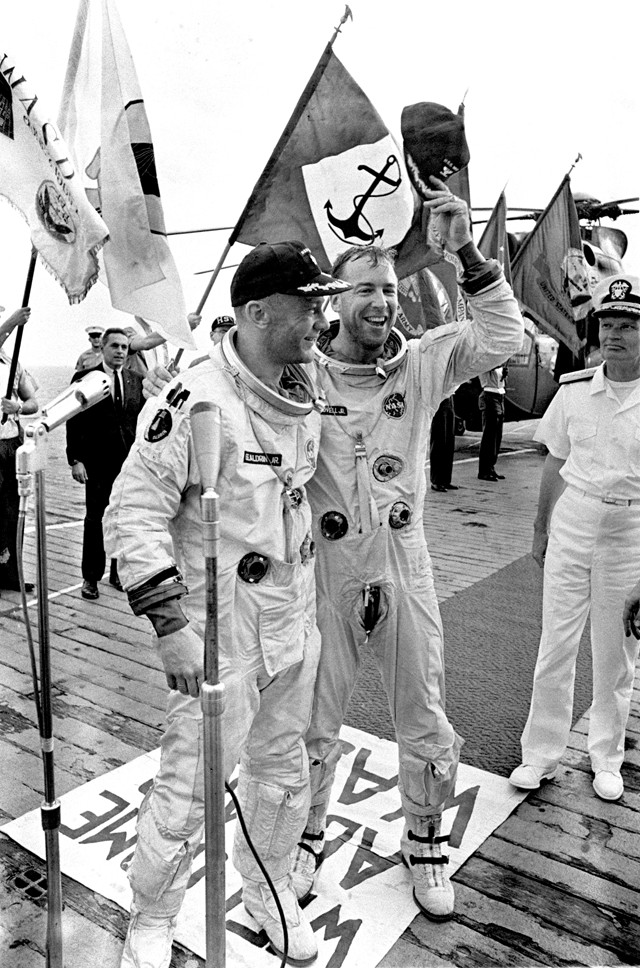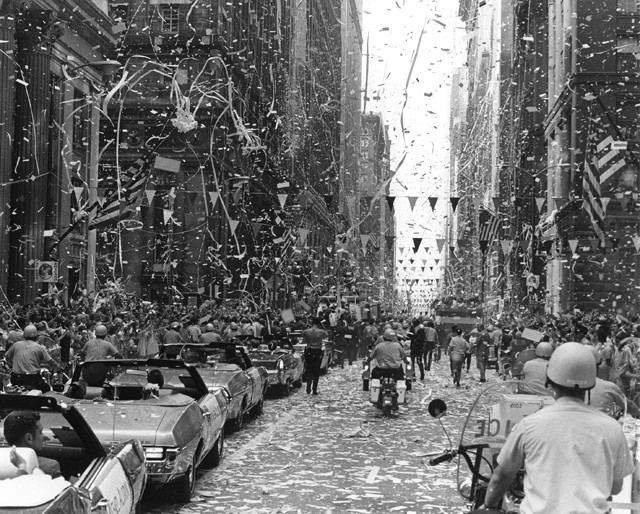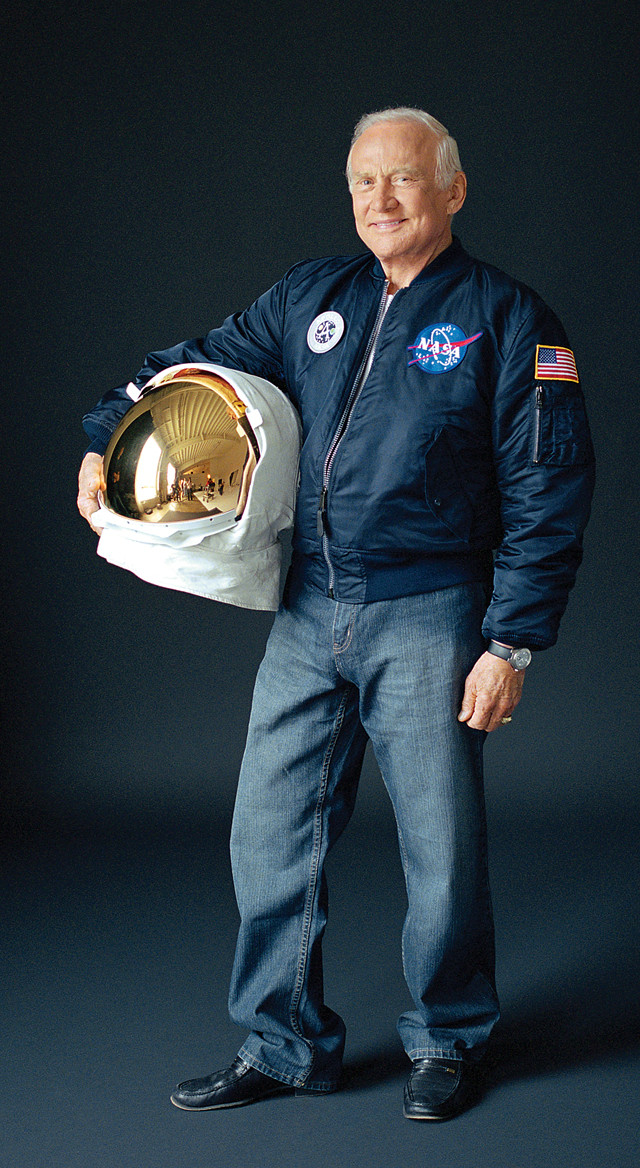
by Zahra Hirji Wednesday, May 23, 2018
On July 20, 1969, Apollo 11 astronauts Buzz Aldrin and Neil Armstrong made history when they landed and walked on the moon. The voyage left a lasting impression on Aldrin, who, at the age of 79, is one of the most vocal supporters of human space exploration.
Aldrin graduated from the United States Military Academy at West Point in New York in 1951 with a B.S. in mechanical engineering and joined the Air Force. He served as a fighter pilot during the Korean War, flying 66 combat missions, and was awarded the Distinguished Flying Cross when he returned home. After the war, Aldrin earned a doctorate in aeronautics from MIT in Cambridge, Mass. His dissertation was on manned orbital rendezvous missions. He got to test his ideas first-hand when NASA selected him as an astronaut in October 1963. To prepare for being in space, Aldrin volunteered to be the first astronaut to undergo underwater training in a full astronaut suit to simulate zero-gravity conditions. And on his first mission, Gemini 12, in 1966, Aldrin completed the first American spacewalk. In 1968, he was chosen for the first manned mission to the moon.
President Richard Nixon presented Aldrin, Armstrong and Apollo 11 pilot Michael Collins with the Presidential Medal of Freedom upon their return from the moon. In the months following, Aldrin toured the world, speaking about his experiences. During these tours, he says he came to realize just how inspiring going to the moon was to the world.
Following his famed moonwalk, Aldrin left NASA and became commandant of the United States Air Force Test Pilot School in 1971. But already by 1970, he was struggling with depression and alcoholism. In 1972, Aldrin went public about his depression. In October 1978, he gave up drinking. And although depression still haunted him for many more years, it stopped being an obstacle in his life in the late 1980s, thanks to the inspiration of space travel — and, he is quick to point out, the support of his wife Lois, whom he married in 1988.
Aldrin now spends his time promoting space travel any way he can: He has spoken in front of Congress, produced a rap song about space with rapper Snoop Dogg, and now penned a new autobiography, “Magnificent Desolation,” about his life after returning from the moon. He recently spoke with EARTH’s Zahra Hirji about his passionate views on space.

Astronauts Buzz Aldrin and Jim Lovell are welcomed aboard the aircraft carrier U.S.S. Wasp after their Gemini 12 spacecraft splashed down in the Atlantic Ocean in 1966. Credit: NASA
ZH: What do you consider your biggest accomplishment since walking on the moon?
BA: Recovering a very active open mind and alertness, and expanded operating capabilities [after suffering depression].
ZH: Part of your recovery from alcoholism and depression was to get involved in promoting the importance of space exploration and making space exploration accessible to civilians, such as through space tourism.
BA: Tourism is kind of a misnomer. The only person I know who wants to be a tourist is the first tourist [Dennis Tito]. He kind of likes that designation.
ZH: How would you phrase it?
BA: Adventure travel. Also, I think calling suborbital passengers “astronauts” does a disservice to national and international efforts. A more appropriate terminology is “star flyer” for suborbital travel and “star traveler” for orbital adventure travel. And promoting “star traveling/flying” is only one part of my interest in the global nature of national space visions. I am advocating a unified space vision.
ZH: What does this vision involve?
BA: First is that the United States should retain global leadership in space transportation to and from orbit in rockets and spacecraft, in propulsion and spacecraft technology, and in overall leadership and transportation. Second is that the United States should assist other nations in landing humans on the moon. The United States can do this by providing robotic assistance, but we should not feel compelled to share our technology on how to get humans there. Furthermore, the United States should avoid a space race, and avoid repeating something we’ve already done — sending humans to the moon — and instead develop the moon robotically until it’s clear that human missions are a real necessity. That way we can focus our resources beyond the moon in a pathway to Phobos, the moon of Mars, before surface landings [on Mars] on 2035, possibly 2031.

Neil Armstrong, Michael Collins and Buzz Aldrin received a hero's welcome in Chicago, Ill., in 1969, following their return from the moon. Credit: NASA
ZH: Why the year 2035?
BA: From the Wright Brothers’ 1903 flight to landing on the moon was 66 years, so I just added 66 years to 1969 and got 2035. I think we should at least progress from the surface of the moon to the surface of Mars in an equal time.
ZH: Is going to Mars feasible with today’s technology?
BA: Absolutely, but we need resources and commitment. We have already sent Voyager [a NASA spacecraft] outside the solar system. But it ain’t coming back [laughs]. We need a commitment to permanence on Mars. Not just several visits that will then end up as earmarks for politicians. This does not require large resources, just a clear pathway now and a steady supply of resources. Or a change of direction [in NASA goals] around the 50th anniversary of landing on the moon, 2019.
ZH: What kind of change in direction?
BA: If we decide by 2019 that we are going to miss something [in landing on Mars], we should change course and go to [Mars’] moon [Phobos]. If we decide we are not ready to go to the moon Phobos, then we can mine asteroids.
And if we decide we don’t want to do any of that, we can pull back to the surface of Earth and forget space travel. We do not need humans in low-Earth orbit — robots can do a great job. And robots will do a great job at the surface of the moon, but I think the future of the world and the nation requires the inspiration and demonstration of leadership by a gradual expanding, expiring set of stepping stones to outer orbit.
ZH: When you were an astronaut, being a pilot was very important. Now that technology has gotten better, however, piloting skills are less critical. What do you predict will be important qualities for the astronauts who travel to Mars?
BA: Looking to the future, we need people who are compatible for long periods of time, who can become very cooperative team players with varieties of skills — not so much operators coordinating the operation of spacecraft or piloting skills, but more monitoring automated actions of the computer-controlled spacecraft. More like “Star Trek” — sitting at a console.
ZH: What kind of hardships will the Mars-destined crew face?
BA: Certainly physical and mental ones. There is going to be radiation to deal with and body inactivity. We will have to remedy deterioration. Also, we need to expose people to travel in small units over long periods of time. I think we can do some of that at the space station — not six-month periods but at least one year and maybe more. And then add maybe one-year missions beyond the moon, followed by missions on the order of two and a half to three years.
ZH: You mentioned “Star Trek.” To what extent has science fiction influenced the development and direction of technology in the past and today?
BA: I think the early authors — people like Arthur C. Clarke, Ray Bradbury and Isaac Asimov — did inspire thinking of expanding the realistic capabilities of technology. The present science fiction launches into bizarre fantasy, just to titillate the reader and promote false attractiveness. When creatures start oozing out of chests of people and there are scissor-finger people, it doesn’t ring true to a progression of reality. But the earlier science fiction, I would have called it “technology projection”: projecting the advancements in technology and how they might differ in different societies. Today there is a convenience that is opted for beaming people up and down to save discussing difficult landing and lift-off matters. And to get somewhere in a hurry, it is OK to violate the speed of light. There is certainly enough reality with known limitations.
The most prominent achievement was landing on another object. A human-created object landing on a natural object opened the door to the idea of creatures being able to open the door and walk around and to do the same thing on other objects in space.

Buzz Aldrin. Credit: NASA
ZH: When you were on the moon, were you ever tempted to do anything against regulation that was more fun, like do a back flip?
BA: No. I am extremely cautious and, as a matter of fact, the lunar module pilot on the second landing and I agreed initially that even hitting a golf ball was an inappropriate use of taxpayer time on the moon. But we later changed our minds and decided that that was what the American people wanted to see. … But I think demonstrations like dropping a feather and a hammer at the same time somehow escaped most people, and that’s a shame because that was far more constructive than topping a golf ball or doffing it [laughs].
ZH: It has been 40 years since you were on the moon. How do you feel when you look at the moon now?
BA: Not much different, but I can give you the trite answer that it’s no longer a stranger, but a friend [laughs]. But seriously, it is the same moon until you get quite close and then it becomes a very rough and rugged moon. Then when you are on it, it becomes a desolate magnificence of human achievement, but lifeless. Totally lifeless surroundings.
© 2008-2021. All rights reserved. Any copying, redistribution or retransmission of any of the contents of this service without the expressed written permission of the American Geosciences Institute is expressly prohibited. Click here for all copyright requests.